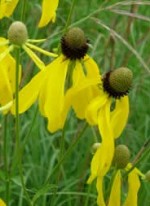 A native of dry prairies and savannas, yellow coneflower has a folksy look with its droopy soft yellow petals. The center cone is green at first but changes to dark purple or brown. The bloom period is in summer and last 1-2 months. The leaves are coarse and rough to the touch because of the many stiff hairs that cover their surface. The stems are long and slender so the plants tend to be floppy. Yellow coneflower tolerates a wide range of soils but prefers medium to somewhat dry conditions and is drought tolerant. It thrives in full sun but also does well in part shade. Many insects use yellow coneflower as a food source including a variety of bees, butterflies, moths, beetles, wasps, and flies. Flowers are good for flower arrangements.
A native of dry prairies and savannas, yellow coneflower has a folksy look with its droopy soft yellow petals. The center cone is green at first but changes to dark purple or brown. The bloom period is in summer and last 1-2 months. The leaves are coarse and rough to the touch because of the many stiff hairs that cover their surface. The stems are long and slender so the plants tend to be floppy. Yellow coneflower tolerates a wide range of soils but prefers medium to somewhat dry conditions and is drought tolerant. It thrives in full sun but also does well in part shade. Many insects use yellow coneflower as a food source including a variety of bees, butterflies, moths, beetles, wasps, and flies. Flowers are good for flower arrangements.
Type: Herbaceous perennial
Bloom: Daisy-like flowers 1-2.5” across have yellow ray flowers and green disc flowers that age to purple or brown; bloom period begins in early to late summer and lasts 1-2 months.
Foliage: Irregular basal leaves, some pinnately divided into 3-7 lobes; smaller upper leaves are lanceolate.
Size: 3-5’ H x 1.5-2’ W
Light: Full sun to part sun
Soil: Average, medium moist, well-drained but tolerates a wide range of soils
Hardiness: Zones 3-7
Care: May need staking.
Pests and Diseases: None of significance
Propagation: Seed in fall; stratified seed in spring
Companion plants: Blazing star (Liatris aspera), purple coneflower (Echinacea purpurea), Anise hyssop (agastache-foeniculum), western ironweed (Vernonia fasiculata), and wild bergamot (Monarda fistulosa).
